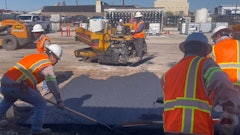Nothing is worse than warranty work. We all have it for one reason or another. Sometimes it's our fault, sometimes it's not. So what’s the best approach to handling warranty claims?
The first thing every contractor needs is a clear policy. But can such a policy ever be clear in the asphalt business? There are so many variables that affect each element of our work -- whether paving, sealing, or striping – that it’s difficult to cover all variables in one policy.
But we try.
At T & N Asphalt Services we have always followed what seems to be an unwritten “industry standard” and offered a one-year service warranty. This covers labor to fix a material problem (and said material should be covered by the manufacture, providing it was installed correctly). But even with a one-year warranty there has always been one tough issue: Who pays to restripe? Having a clear policy that outlines what is and isn’t covered -- as well as who pays for what should warranty work be required -- can easily help avoid conflicts should warranty work be needed.
A new trend in sealcoating is long-term, five-year warranties. Wait… five years? Yes, five years. I’m baffled by this as we recommend reapplication of sealer every three to five years. I always say that I want the client to call in five years for another coating, not for a warranty claim. Most five-year warranties are prorated, which makes a little sense, but I still think that a prorated policy will ruffle more feathers than its worth as an aspect of your marketing.
Over the years we have reduced warranty claims to near zero, but it has come with some lost revenue. In my experience, pushing the weather envelope is the primary reason for failures (other typical reasons are lots that aren’t cleaned properly or are too far gone to be sealed), so we don't start sealing until June – and sometimes that’s two months after our #LowBid competition starts sealing. We also will end sealcoating prior to October 1 – that’s as much as a month earlier then the same #LowBid competitors. We are also super picky about making sure the parking lot we’re going to pave or seal is a proper candidate for that process.
So, what’s the best method when you get a call to look at a problem? We feel our one-year policy is effective yet flexible -- in the sense that we want to keep the client happy. We respond quickly and willingly look at the issue. Showing that you care enough to respond quickly can set the tone as you work through the problem.
When we look at the issue, we are very clear that we aren’t responsible for normal wear and tear, though it can be hard to convey what’s “normal” and what’s not. If there is even a chance it's our fault, we will fix it. We also will restripe provided it’s not a huge, catastrophic failure. In the case of a huge, catastrophic failure, our supplier would be involved and costs would be shared between us, and even with the site owner.
I will also point out that when we have been called to look at issues that (after review) aren’t our fault, we explain the issue to the customer, then we might offer to fix the pavement at a discount. That gives us a good opportunity to shine just by being responsive and flexible. For us, keeping the customer happy is well worth it, but that’s provided they are reasonable.
The bottom line to warranty issues is clear communication from the very beginning, a quick response to questions or concerns, and a fair fix provided it's an actual warranty issue.


























